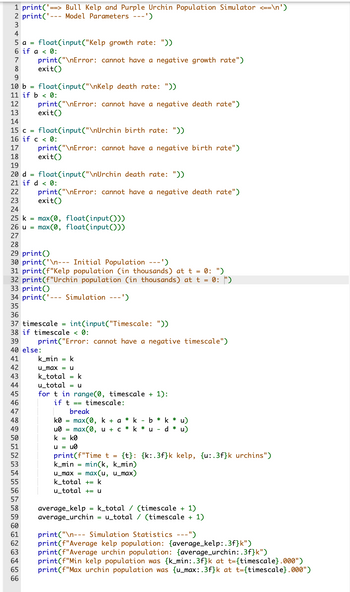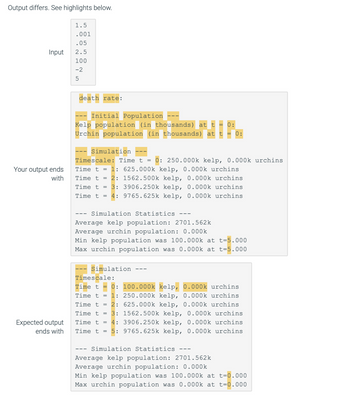
Database System Concepts
7th Edition
ISBN: 9780078022159
Author: Abraham Silberschatz Professor, Henry F. Korth, S. Sudarshan
Publisher: McGraw-Hill Education
expand_more
expand_more
format_list_bulleted
Question
thumb_up100%
This is my code in python I keep getting these errors that do not match the expected output, I confused on what I did wrong how do I correct this.

Transcribed Image Text:# Bull Kelp and Purple Urchin Population Simulator
## Model Parameters
This simulator models the interaction between Bull Kelp and Purple Urchin populations. Users input growth and death rates for each species. Rates must be non-negative.
### Kelp Parameters:
- **Growth Rate (`a`)**: The rate at which the kelp population grows.
- **Death Rate (`b`)**: The rate at which kelp dies.
**Error Handling**: Negative input for rates results in an error message and exits the program.
### Urchin Parameters:
- **Birth Rate (`c`)**: The rate for urchin population increase.
- **Death Rate (`d`)**: The rate of urchin mortality.
**Error Handling**: Similar checks and errors apply to urchin rates.
### Initial Population
- Users set initial populations for kelp and urchins (in thousands).
### Simulation
- **Timescale**: Users input the duration for the simulation. Negative timescales trigger an error.
#### Computation:
- Uses a loop over the timescale to calculate changes in populations.
- Updates kelp (`k`) and urchin (`u`) populations each iteration.
- Calculates minimum, maximum, and total populations for kelp and urchins.
### Results:
- The output includes average populations for kelp and urchins, as well as minimum and maximum populations recorded during the simulation.
This simulator allows exploration of ecological interactions, promising insights into population dynamics through customizable parameters and initial conditions.

Transcribed Image Text:## Simulation and Input Data
### Input Values
- Parameter 1: 1.5
- Parameter 2: 0.001
- Parameter 3: 0.05
- Parameter 4: 2.5
- Parameter 5: 100
- Parameter 6: -2
- Parameter 7: 5
### Simulation Explanation
#### Your Output
**Death Rate and Initial Population**
- **Kelp Population** at \( t = 0 \): 250.000k
- **Urchin Population** at \( t = 0 \): 0.000k
**Simulation Over Time**
- **Time \( t = 0 \)**: 250.000k kelp, 0.000k urchins
- **Time \( t = 1 \)**: 625.000k kelp, 0.000k urchins
- **Time \( t = 2 \)**: 1562.500k kelp, 0.000k urchins
- **Time \( t = 3 \)**: 3906.250k kelp, 0.000k urchins
- **Time \( t = 4 \)**: 9765.625k kelp, 0.000k urchins
**Simulation Statistics**
- **Average Kelp Population**: 2701.562k
- **Average Urchin Population**: 0.000k
- **Min Kelp Population**: 100.000k at \( t = 5.000 \)
- **Max Urchin Population**: 0.000k at \( t = 5.000 \)
#### Expected Output
**Simulation Over Time**
- **Time \( t = 0 \)**: 100.000k kelp, 0.000k urchins
- **Time \( t = 1 \)**: 250.000k kelp, 0.000k urchins
- **Time \( t = 2 \)**: 625.000k kelp, 0.000k urchins
- **Time \( t = 3 \)**: 1562.500k kelp, 0.000k urchins
- **Time \( t = 4 \)**: 3906.250k kelp, 0
Expert Solution
arrow_forward
Step 1: Errors in the program
There are extra printing statements in the original code. Therefore, the expected output does not match your output.
If any other statement doesn't match, kindly remove any extra print statement.
Step by stepSolved in 3 steps with 1 images

Knowledge Booster
Learn more about
Need a deep-dive on the concept behind this application? Look no further. Learn more about this topic, computer-science and related others by exploring similar questions and additional content below.Similar questions
- Write an assembly function that uses a for loop to multiply all the numbers from 1 through and including N. Return the result. Print the returned value. Hello I was hoping someone could run through this code step by step as I am new to Assembly language, thank you!arrow_forwardCis compiler dependent. a. False O b. Truearrow_forwardWhat are three options you have if you still can't solve the issue after using the debugging process?arrow_forward
- Please please please don't copy other solutions with diffrent numbers other than the question please and use python not MATLAB Question asks for x=15 and x=-15 while n ranging between 1 and 80 so I hope to see the code using this numbers Question: We can use the sum of the first n terms of the Taylor series of e^x with a=0 to estimate the value of the exponential function.Using a logarithmic y axis, plot the fractional error in the estimated e^x (compared to numpy.exp(x)) as a function of n (n ranging between 1 and 80) for (a) x = 15 and (b) x = −15. [You can plot the two cases either as different curves on the same plot or in different plots, whichever is clearer.] Please answer this question *FULLY* in python showing the whole code I would appreciate your help alotarrow_forwardPlease answer 2 python questions. Thank you.arrow_forwardWhat is the intuition behind using a loop statement? What do you gain from using loops in your code? How do you think loops in Python provide code reusability?arrow_forward
arrow_back_ios
arrow_forward_ios
Recommended textbooks for you
 Database System ConceptsComputer ScienceISBN:9780078022159Author:Abraham Silberschatz Professor, Henry F. Korth, S. SudarshanPublisher:McGraw-Hill Education
Database System ConceptsComputer ScienceISBN:9780078022159Author:Abraham Silberschatz Professor, Henry F. Korth, S. SudarshanPublisher:McGraw-Hill Education Starting Out with Python (4th Edition)Computer ScienceISBN:9780134444321Author:Tony GaddisPublisher:PEARSON
Starting Out with Python (4th Edition)Computer ScienceISBN:9780134444321Author:Tony GaddisPublisher:PEARSON Digital Fundamentals (11th Edition)Computer ScienceISBN:9780132737968Author:Thomas L. FloydPublisher:PEARSON
Digital Fundamentals (11th Edition)Computer ScienceISBN:9780132737968Author:Thomas L. FloydPublisher:PEARSON C How to Program (8th Edition)Computer ScienceISBN:9780133976892Author:Paul J. Deitel, Harvey DeitelPublisher:PEARSON
C How to Program (8th Edition)Computer ScienceISBN:9780133976892Author:Paul J. Deitel, Harvey DeitelPublisher:PEARSON Database Systems: Design, Implementation, & Manag...Computer ScienceISBN:9781337627900Author:Carlos Coronel, Steven MorrisPublisher:Cengage Learning
Database Systems: Design, Implementation, & Manag...Computer ScienceISBN:9781337627900Author:Carlos Coronel, Steven MorrisPublisher:Cengage Learning Programmable Logic ControllersComputer ScienceISBN:9780073373843Author:Frank D. PetruzellaPublisher:McGraw-Hill Education
Programmable Logic ControllersComputer ScienceISBN:9780073373843Author:Frank D. PetruzellaPublisher:McGraw-Hill Education

Database System Concepts
Computer Science
ISBN:9780078022159
Author:Abraham Silberschatz Professor, Henry F. Korth, S. Sudarshan
Publisher:McGraw-Hill Education

Starting Out with Python (4th Edition)
Computer Science
ISBN:9780134444321
Author:Tony Gaddis
Publisher:PEARSON

Digital Fundamentals (11th Edition)
Computer Science
ISBN:9780132737968
Author:Thomas L. Floyd
Publisher:PEARSON

C How to Program (8th Edition)
Computer Science
ISBN:9780133976892
Author:Paul J. Deitel, Harvey Deitel
Publisher:PEARSON

Database Systems: Design, Implementation, & Manag...
Computer Science
ISBN:9781337627900
Author:Carlos Coronel, Steven Morris
Publisher:Cengage Learning

Programmable Logic Controllers
Computer Science
ISBN:9780073373843
Author:Frank D. Petruzella
Publisher:McGraw-Hill Education